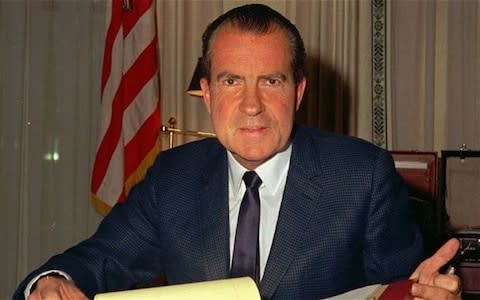What is impeachment and how long does the process take?

Impeachment is a rarely used tool used to oust a sitting US president from power, and since Donald Trump became president chatter around the "I" word has increased in Washington circles.
It first arose following accusations last year that Mr Trump has obstructed justice, but speculation began growing after the Democrats took control of the House of Representatives in November in the midterm elections.
Nancy Pelosi initially ruled out impeaching Mr Trump, citing opinion polls showing the public were not on board. She would note the need for a bipartisan approach if impeachment is to have a chance of succeeding.
But the House Speaker has now changed her mind. In September, Mrs Pelosi announced the Democrats will begin impeachment proceedings against the US president.
She said the trigger was claims that Mr Trump held back aid to Ukraine in the hope its leader would investigate Joe Biden, the former US vice president who is seeking the White House in 2020.
Here is a look at exactly what impeachment is and where it's been used before.
Head here to read the latest news from the inquiry.
What is impeachment?
Impeachment is the process by which Congress puts certain officials, namely the president, on trial.
The constitution lays out a broad scope of offences that can lead to impeachment: “Treason, bribery, or other high crimes and misdemeanors."
How does it work and how many votes are needed?
Impeachment does not mean a president will necessarily be kicked out of office. It proceeds like a bill passing through legislature.
First, a majority in the House of Representatives - 218 out of 435 members - must approve articles of impeachment previously approved in committee.
The make-up of the House before the 2018 midterm elections favoured Mr Trump, with Republicans holding 238 seats while Democrats held 193. (Four seats were vacant.)
Now, however, the Democrats control the chamber.
If it passes the House, it goes to the Senate, where a two-thirds majority vote is needed to convict the president and consequently remove him from office.
Given the Republicans kept control and even gained seats in the Senate in 2018, it is highly unlikely Congress would remove him from office.
The Senate now has 53 Republicans, 45 Democrats and two independents who usually vote with the Democrats. Conviction and removal of a president would require 67 votes. So, for Mr Trump to be removed from office via impeachment, at least 20 Republicans and all the Democrats and independents would have to vote against him.
The Republican majority in the Senate could vote to immediately dismiss the charges against Mr Trump without considering evidence.

Is there an election after a presidential impeachment?
In the event Mr Trump was impeached, Vice President Mike Pence would immediately take the oath of office and become president.
Should Mr Pence be impeached too, then the Speaker of the House, Mrs Pelosi, would take the top job.
Do impeached officials go to prison?
Impeachment is a political process, not criminal.
Congress has no power to impose criminal penalties on impeached presidents or officials. However criminal courts could try to punish officials if they are believed to have committed crimes.
"There isn't any judicial review of impeachment decisions, so Congress just needs to be satisfied that Trump committed high crimes or misdemeanors," Jens David Ohlin, a law professor and associate dean at Cornell Law School said.
"They are the ultimate judge of what meets that standard."
Impeachment therefore is at the crossroads of politics and the law. "There's no requirement that the president must have been indicted" for a crime, Ohlin added.

History of impeachment
No US president has ever been ousted from office under impeachment proceedings.
Andrew Johnson was the first leader to go through the process in 1868. He was charged with breaking the law after he tried to replace the US secretary of war, Edwin Stanton, without congressional permission.
At the time - in the aftermath of the civil war - the president was required to consult the Senate about such decisions. His impeachment passed to the Senate, where he escaped being removed from office by a one-vote margin.
The other president was, of course, Bill Clinton over the Monica Lewinsky scandal. He was impeached for perjury and obstruction of justice in 1998, but he was acquitted in the Senate trial.
Richard Nixon would almost certainly have faced impeachment proceedings in 1974 over the Watergate scandal and undoubtedly would have been removed from office. However, the disgraced president resigned before it got that far and he handed the presidency over to Gerald Ford.

